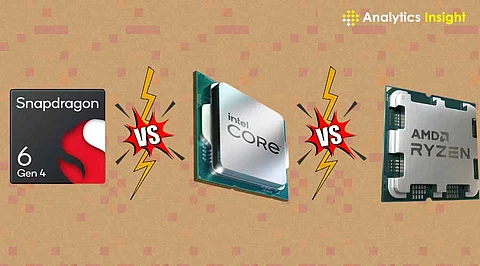

In recent times, AI-powered PCs are the most trending ones. The more the chip manufacturers have been pushing their boundaries, the more PCs have become more efficient in their performance and AI capabilities. In this race, new contenders are joining every day, and Qualcomm’s Snapdragon X series has recently emerged as one of the strongest contenders against industry giants like AMD and Intel. Now that the dominance of these two chips has been challenged, here’s a comparison to check whether Snapdragon X will overcome Intel and AMD.
While Intel and AMD have been in this field for a long time, Qualcomm’s Snapdragon X came only recently, but since it was launched, this series marks a significant leap forward for AI-driven computing. From ARM architecture to energy-efficient and always-connected PCs, these Qualcomm chips are always best to use. The most standout part of these chips is their Snapdragon X processors that feature a dedicated Neural Processing Unit (NPU), which is capable of accelerating AI workloads more than traditional CPUs and GPUs.
Aside from that, there’s another key feature that one can’t ignore about Snapdragon X, and that is its power efficiency. These chips are built on a smaller fabrication process, which enables them to have excellent battery life. This ability again makes these chips compatible with ultra-thin laptops and 2-in-1 devices.
Apart from that, Snapdragon X chips integrate seamlessly with Windows on ARM. This seamless integration allows better compatibility with x86 applications through enhanced emulation and support for AI-driven tasks.
The next feature which is another major strength of Snapdragon X is its connectivity. Because the Qualcomm Snapdragon X was released only recently, it comes with built-in wireless technology, and its chips come with built-in 5G and Wi-Fi 6E capabilities. This ensures that AI-powered PCs will be connected to the network all the time.
Snapdragon X is indeed making waves, but Intel and AMD are the two most established companies in this field. Therefore, leaving them behind is not something that Qualcomm can easily achieve. Instead, it is going to be hard for any competitor to take their position. Both Intel and AMD have been actively integrating AI into their next-gen processors.
For example, Intel’s latest Core Ultra series has incorporated the Intel AI Boost, which is a dedicated AI accelerator. The company is also bringing hybrid architecture, which is combining performance and efficiency cores to optimize workloads more efficiently than before. Furthermore, Intel has partnerships with software developers that ensure that the AI applications are well-optimized for its x86 architecture to provide users who are more fond of AI-driven workflows.
Similarly, AMD Ryzen is not behind. This company has also been adapting significant steps to improve its AI performance. As the AI advancement has begun, AMD has also started integrating AI accelerators into its latest Ryzen processors to enhance machine learning, content creation, and gaming. AMD’s strength lies in its powerful GPU and CPU integration. These seamless integrations generally provide users with excellent AI processing capabilities. The best part is that AI processing capabilities never cost the overall system performance. Additionally, AMD has introduced its latest AI-enhanced APUs (Accelerated Processing Units) to improve efficiency, performance, and power consumption.
The competition between these three companies has been hard. The more the landscape of AI-powered PCs has been evolving, the more the competition between Snapdragon X, Intel, and AMD is getting intense. Each company brings unique advantages to the table, making it hard for consumers to decide who’s the best.
Snapdragon X leads the AI-powered PC market in power efficiency and connectivity. The use of these PCs ensures that applications run at a faster speed, without lagging. Most importantly, its dedicated NPU provides strong AI acceleration. Despite that, its software compatibility with x86-based applications makes it a doubtful choice for any user.
Next, when it comes to Intel, this tech giant has always been maintaining its stable position in the AI PC market. The primary reason behind that is its extensive software ecosystem and powerful x86 architecture. Therefore, no matter who the competitor is, Intel is still the best choice for anyone who wants to have an AI-powered PC for personal use or professional work.
Finally, comes AMD. Since AMD came, it has been challenging Intel’s dominance and is carving out a strong position with its Ryzen AI processors. These processors provide users with a balanced AI performance and power efficiency. In the growing demand for AI-enhanced GPUs and CPUs, AMD is positioning itself as a powerful alternative to Intel, especially for those who are looking for high-performance computing.
In this rapidly growing AI-powered PC market, Qualcomm, Intel, and AMD have been taking different approaches to make their position solid. All of them have their advantages and disadvantages. Therefore, the leader in the AI PC market will finally be decided on software optimization, hardware efficiency, and consumer adoption.
